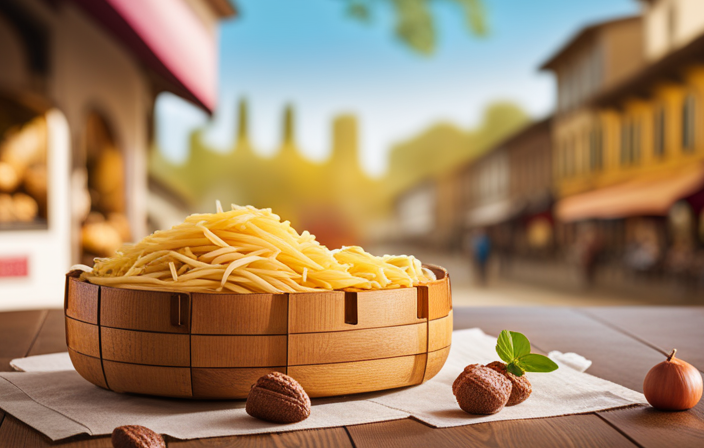As a passionate food lover, I’m always on the lookout for new gastronomic adventures. Recently, I had the pleasure of discovering Emilia Romagna, an Italian region renowned as the Food Valley.
Let me tell you, it was an experience like no other. From savoring the exquisite Prosciutto di Parma to indulging in the rich flavors of Parmigiano Reggiano and Modena Balsamic Vinegar, this gastronomic journey has left an indelible mark on my taste buds.
Join me as I take you on a captivating exploration of Emilia Romagna’s culinary treasures.
Key Takeaways
- Prosciutto di Parma and Parmigiano Reggiano are two designated Italian staples that must be produced in the Parma region.
- Traditional Balsamic Vinegar (TBV) can only be found in Emilia Romagna, particularly in Modena, and is aged for a minimum of 12 years.
- Bologna is a vibrant city with a rich culinary scene, known for its mortadella, a gourmet lunch meat made with finely hashed pork.
- The Emilia Romagna region is renowned as the Food Valley of Italy, offering a variety of gastronomic experiences and allowing for an immersion into local culture and culinary traditions.
Prosciutto Di Parma: a Taste of Tradition
I absolutely love the sweetness balanced with salt and the thin slices of Prosciutto di Parma, a designated Italian staple that must be produced in the Parma region.
When exploring the curing techniques and traditional production methods of this delicious ham, you’ll discover a meticulous process that has been passed down for generations.
The first step involves selecting the finest breed of pigs and carefully salting the leg to draw out moisture and enhance the flavor. The ham is then hung to dry in the open air, allowing natural breezes to work their magic.
After this initial curing stage, the Prosciutto di Parma is aged in dark cellars for up to 36 months, developing its unique taste and texture. The result is a mouthwatering delicacy that embodies the essence of Italian craftsmanship.
Parmigiano Reggiano: The King of Cheeses
Made with raw milk from the region, Parmigiano Reggiano is a hard granular cheese that is aged for a minimum of 12 months. The aging process is what gives this cheese its unique flavor and texture. As it ages, Parmigiano Reggiano develops a rich and nutty taste, with hints of sweetness and a crumbly yet firm texture.
But it’s not just the taste that sets Parmigiano Reggiano apart, it also offers a range of nutritional benefits. Packed with calcium, protein, and vitamins, this cheese is a great source of nutrients. Additionally, the aging process breaks down lactose, making it easier to digest for those with lactose intolerance.
So not only is Parmigiano Reggiano delicious, but it’s also a healthy addition to your diet.
Exploring Modena’s Balsamic Vinegar Heritage
Exploring Modena’s balsamic vinegar heritage is a fascinating experience that allows you to delve into the rich history and traditional production methods of this renowned Italian delicacy. The significance of Modena in balsamic vinegar production cannot be overstated. Here are five reasons why this exploration is so captivating:
-
Uncovering the secrets of traditional production methods, passed down through generations, that give Modena’s balsamic vinegar its unique flavor and complexity.
-
Learning about the meticulous process of aging the vinegar for a minimum of 12 years, sometimes even up to 25 years or more, to achieve its distinctive taste and aroma.
-
Discovering the strict regulations and PDO designation that ensure the authenticity and quality of Modena’s balsamic vinegar.
-
Understanding how Modena’s favorable climate and soil contribute to the cultivation of the grapes used in making this exquisite vinegar.
-
Appreciating the cultural and historical significance of balsamic vinegar in the region, and how it has become a symbol of Modena’s culinary heritage.
Embarking on this exploration will not only satisfy your taste buds but also deepen your appreciation for the artistry and craftsmanship that goes into producing Modena’s balsamic vinegar.
Bologna: A Culinary Wonderland
Bologna’s culinary scene and famous landmarks make it a must-visit destination for any food lover. Exploring Bologna’s street food is like unraveling a culinary wonderland. The city’s covered porticos and sidewalk markets exude an irresistible charm. As you stroll through the streets, tantalizing aromas of freshly baked bread and simmering ragù fill the air. Uncovering Bologna’s culinary history is a journey that takes you back centuries. The city is famous for its mortadella, a gourmet lunch meat made with finely hashed pork and a secret blend of spices. And let’s not forget about the iconic Piazza Maggiore, where you can indulge in a plate of handmade tortellini while admiring the stunning architecture. Bologna truly is a paradise for food enthusiasts, offering an immersive experience into the region’s rich culinary traditions.
| Bologna’s Culinary Scene | Famous Landmarks | Street Food |
|---|---|---|
| Vibrant and diverse | Piazza Maggiore | Mortadella |
| Covered porticos | Two Towers | Tortellini |
| Sidewalk markets | Basilica di San | Gelato |
| Petronio | ||
Emilia Romagna: The Food Valley Experience
I can’t wait to immerse myself in the culinary delights of Emilia Romagna and experience the Food Valley firsthand. This region is known for its incredible food and wine, and I am eager to wine and dine my way through its traditional pasta dishes.
Here are four reasons why Emilia Romagna is a must-visit destination for any food lover:
-
Prosciutto di Parma: Indulge in the world-famous cured ham, made from specially selected pigs and aged in dark cellars for up to 36 months. Its sweetness balanced with salt and thin slices make it a true delicacy.
-
Parmigiano Reggiano: Taste the authentic hard granular cheese made with raw milk from the region. Aged for a minimum of 12 months, this cheese is produced in a natural environment with no additives, unlike the grated Parmesan found in supermarkets.
-
Modena Balsamic Vinegar: Discover the traditional balsamic vinegar, made from regional grapes and aged for a minimum of 12 years. Its production is strictly regulated and receives the PDO designation.
-
Bologna: Explore the vibrant city known for its covered porticos, arcades, and sidewalk markets. Don’t miss out on trying the famous mortadella, a gourmet lunch meat made with finely hashed pork, incorporating white cubes of fat and a secret blend of spices.
Emilia Romagna is truly a Food Valley experience that promises to delight your taste buds and leave you craving for more.
Unveiling the Secrets of Prosciutto Di Parma
Sampling the world-famous Prosciutto di Parma is a culinary experience like no other. This specially selected cured ham is aged for up to 36 months in dark cellars, resulting in a delicate balance of sweetness and salt.
Prosciutto di Parma has a rich history and holds significant cultural significance in the Parma region of Italy. The process of aging and curing this exquisite ham involves carefully salting and hanging the leg to dry with natural breezes. The ham is then transferred to dark cellars, where it slowly matures over time.
This meticulous process allows the flavors to intensify and develop, creating a unique and unforgettable taste. The result is a perfectly cured prosciutto with a tender texture and a mouthwatering aroma.
Whether enjoyed on its own or as a part of a delicious antipasto platter, Prosciutto di Parma is a true culinary masterpiece that showcases the art of Italian charcuterie.
Parmigiano Reggiano: From Farm to Table
Aging for a minimum of 12 months, Parmigiano Reggiano is made with raw milk from the Emilia Romagna region and produced in a natural environment with no additives.
The production process of Parmigiano Reggiano begins with the selection of specific breeds of cattle, whose milk is used to make this authentic Italian cheese. The milk is then heated and mixed with natural whey culture and rennet, which helps in the curdling process.
Once the curds have formed, they are cut into small pieces and left to settle. The curds are then cooked and pressed into their iconic wheel shape. After this, the cheese wheels are immersed in brine to enhance their flavor and texture.
Finally, the wheels are left to age for a minimum of 12 months, during which time they develop their distinct taste and texture. When it comes to tasting notes, Parmigiano Reggiano is known for its rich, nutty flavor, with hints of sweetness and a slightly granular texture.
It pairs well with a variety of foods, from fruits and nuts to pasta and salads.
Modena Balsamic Vinegar: A Liquid Gold Journey
After indulging in the flavors of Parmigiano Reggiano, my culinary journey in Emilia Romagna continues to the enchanting world of Modena Balsamic Vinegar. This liquid gold is a true gem of the region, with its rich history and unique production process.
Exploring the aging techniques of Modena Balsamic Vinegar is like unraveling a centuries-old tradition. Made from carefully selected Lambrusco grapes and other regional varieties, this prized vinegar is aged for a minimum of 12 years, with some varieties maturing for 25 years or more. Each barrel, made of different types of wood, adds its distinct flavor profile to the final product.
Beyond its culinary allure, Modena Balsamic Vinegar holds great cultural significance. Its production is strictly regulated, receiving the prestigious PDO designation. It is an integral part of the region’s heritage, representing the craftsmanship and dedication of the local artisans.
As I delve into this liquid gold journey, I am captivated by the complexity and depth of flavors that Modena Balsamic Vinegar offers. It is a testament to the rich gastronomic traditions of Emilia Romagna, and a true delight to savor.
Discovering the Flavors of Bologna
Exploring the vibrant culinary scene of Bologna, I am amazed by the variety of flavors and local specialties available to indulge in. Bologna’s iconic dishes are truly a delight to savor. Here are some traditional Bolognese recipes that have captured my taste buds:
-
Tortellini: These small pasta pockets are filled with a mixture of meat, cheese, and sometimes vegetables. They are served in a rich, savory broth or with a creamy sauce.
-
Tagliatelle al Ragù: This classic dish features ribbon-like pasta served with a slow-cooked meat sauce. The ragù is made with a combination of ground beef, pork, and vegetables, resulting in a hearty and flavorful sauce.
-
Lasagna Bolognese: Layered with homemade pasta, Bolognese sauce, and béchamel, this lasagna is a true indulgence. Each bite is a perfect balance of creamy and meaty goodness.
-
Mortadella Sandwich: Made with the famous Bologna mortadella, this sandwich is a local favorite. The mortadella is thinly sliced and served on fresh bread, with a touch of mustard and pickles for added flavor.
From the tantalizing tortellini to the comforting lasagna, exploring traditional Bolognese recipes is a culinary adventure that should not be missed.
Emilia Romagna’s Gastronomic Delights
After indulging in the flavors of Bologna, I was eager to continue my gastronomic journey through Emilia Romagna. This region is not only known for its exquisite cured meats and cheeses but also for its vibrant wine culture and traditional pasta dishes.
Emilia Romagna boasts some of Italy’s finest wines, including the famous Lambrusco, a sparkling red wine that perfectly complements the rich flavors of the local cuisine. As I explored the charming vineyards and wineries, I couldn’t help but appreciate the passion and dedication that goes into producing these exceptional wines.
And when it comes to pasta, Emilia Romagna is home to classics like tortellini, tagliatelle, and lasagna. Each dish is meticulously crafted, with hand-rolled pasta and flavorful fillings that showcase the region’s culinary expertise.
From sipping on exquisite wines to savoring traditional pasta dishes, Emilia Romagna’s gastronomic delights continue to amaze and delight me.
The Art of Prosciutto Di Parma
I was captivated by the artistry and precision that goes into crafting Prosciutto di Parma. The selected breed of pigs are cured and aged for up to 36 months, resulting in its renowned sweetness and delicate slices.
The curing process for Prosciutto di Parma involves several meticulous steps:
-
Selection: Only the finest pigs from specific breeds are chosen for the production of Prosciutto di Parma.
-
Salting: The leg of the pig is carefully salted to draw out moisture and enhance flavor.
-
Hanging: The salted leg is then hung to dry in well-ventilated rooms, where natural breezes play a crucial role in the curing process.
-
Aging: After the initial drying, the ham is transferred to dark cellars, where it is left to age for up to 36 months. During this time, the flavors develop and intensify, resulting in the characteristic sweetness and complexity of Prosciutto di Parma.
In contrast, the production process of Parmigiano Reggiano, another iconic product of the region, involves the following steps:
-
Milk Collection: Only raw milk from cows in the designated region is used to make Parmigiano Reggiano.
-
Curdling: The milk is heated and mixed with natural whey and rennet to form curds.
-
Molding: The curds are placed in molds and pressed to remove excess moisture.
-
Aging: The cheese wheels are then aged for a minimum of 12 months, with some aging for several years. During this time, the cheese develops its distinct nutty flavor and crumbly texture.
The production processes of Prosciutto di Parma and Parmigiano Reggiano reflect the rich traditions and dedication to quality that are synonymous with Emilia Romagna’s gastronomic heritage.
Parmigiano Reggiano: A Cheese Lover’s Dream
Sampling Parmigiano Reggiano is like tasting a cheese lover’s dream come true. Its nutty flavor and crumbly texture perfectly complement a variety of dishes. This iconic Italian cheese goes through a meticulous aging process that enhances its unique characteristics. It is aged for a minimum of 12 months, but some varieties are aged for up to 36 months. This longer aging results in a more intense flavor and a slightly grainy texture. The aging process gives Parmigiano Reggiano its distinct complexity and depth of flavor.
When it comes to pairing suggestions, this versatile cheese pairs well with a wide range of accompaniments. Try it with sweet and tangy fruits like pears and figs. You can also drizzle it with balsamic vinegar or enjoy it alongside a glass of red wine. Whether grated over pasta or enjoyed on its own, Parmigiano Reggiano is a cheese that never disappoints.
Modena Balsamic Vinegar: A Taste of Tradition
Exploring the rich tradition of Modena Balsamic Vinegar, one can taste the unique flavors and complexity that come from its meticulous production process. Modena Balsamic Vinegar is made using traditional production methods that have been passed down through generations.
The aging process of TBV is one of the key factors that contribute to its exceptional taste. TBV is aged for a minimum of 12 years, with some varieties aged for 25 years or more. During the aging process, the vinegar develops a rich, syrupy texture and a sweet, tangy flavor.
The barrels used for aging are made from different types of wood, such as oak, cherry, and chestnut, which impart their own distinct notes to the vinegar. This careful aging process creates a vinegar that is truly unparalleled in taste and quality.
Bologna: A Culinary Exploration
Bologna’s vibrant culinary scene and famous landmarks create an exciting adventure for food enthusiasts like me.
Exploring Bologna’s street food scene is like uncovering hidden culinary gems. From the bustling markets to the small food stalls tucked away in narrow alleys, there is a treasure trove of flavors waiting to be discovered.
One must-try street food in Bologna is the piadina, a thin flatbread filled with delicious ingredients like prosciutto, cheese, and arugula. Another must-try is the crescentina, a fluffy fried bread served with various cured meats and cheeses. And of course, no visit to Bologna is complete without tasting the famous tortellini, delicate pasta parcels filled with rich meat or cheese.
With each bite, I am transported to a world of authentic Italian flavors and traditions. Bologna truly is a culinary paradise waiting to be explored.
Emilia Romagna’s Culinary Treasures
Experiencing the culinary treasures of Emilia Romagna is a delightful adventure for food enthusiasts like me. This region’s culinary heritage takes us on a journey through history and tradition, unraveling the secrets of Emilia Romagna’s culinary gems.
From the world-renowned Prosciutto di Parma to the exquisite Parmigiano Reggiano and the precious Modena Balsamic Vinegar, this region is a haven for food lovers. Each bite tells a story of centuries-old techniques and unparalleled craftsmanship.
The Prosciutto di Parma is cured in a traditional process, resulting in its sweet and salty flavor, while the Parmigiano Reggiano is aged for a minimum of 12 months, creating its distinct taste and texture. And let’s not forget about Modena Balsamic Vinegar, aged for years to develop its complex flavors.
Emilia Romagna’s culinary treasures are a testament to the region’s dedication to preserving its culinary heritage and sharing it with the world.
Frequently Asked Questions
What Are the Specific Breeds of Pigs Used to Make Prosciutto Di Parma?
The specific breeds of pigs used to make Prosciutto di Parma are selected breed pigs. They are cured in a traditional process involving salting and hanging the leg to dry, resulting in the sweet and salty flavors of the ham.
How Long Does It Take to Age Parmigiano Reggiano?
The aging process of Parmigiano Reggiano can take anywhere from 12 to 36 months, depending on the desired flavor and texture. It is a slow and careful process that results in the distinctive taste of this iconic Italian cheese.
What Types of Grapes Are Used to Make Traditional Balsamic Vinegar in Modena?
The types of grapes used to make traditional balsamic vinegar in Modena are Lambrusco and other regional varieties. The grapes are harvested and fermented using specific techniques. The vinegar is then aged in various types of barrels.
What Are Some Famous Landmarks in Bologna?
Some famous landmarks in Bologna include the Piazza Maggiore, with its stunning architecture, and the city’s covered porticos and arcades. Bologna is also known for its traditional pasta dishes, adding to its culinary charm.
What Is the Secret Blend of Spices Used in Bologna’s Mortadella?
The secret blend of spices used in Bologna’s mortadella is a closely guarded ancient recipe, passed down through generations. Exploring the origins of mortadella reveals a rich historical perspective and uncovers the traditional production methods of this beloved gourmet lunch meat.
Conclusion
Well, after indulging in the exquisite flavors of Prosciutto di Parma, Parmigiano Reggiano, and Modena Balsamic Vinegar, I can confidently say that Emilia Romagna truly is a gastronomic paradise.
This region takes its food seriously, and the result is a culinary journey that will leave you craving for more. From the historic city of Bologna to the picturesque countryside, every corner of Emilia Romagna offers a delicious surprise.
So, if you’re ready to embark on a food-filled adventure that will tantalize your taste buds and leave you in awe, then Emilia Romagna is calling your name.
Bon appétit!










